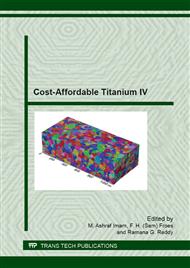[1]
K. Faller, F.S. Froes, The Use of Titanium in Family Automobiles: Current Trends, JOM, 53 (2001) 27-28.
DOI: 10.1007/s11837-001-0143-3
Google Scholar
[2]
M. Long, H.J. Rack, Titanium Alloys in Total Joint Replacement - A Materials Science Perspective, Biomaterials, 19 (1998) 1621-1639.
DOI: 10.1016/s0142-9612(97)00146-4
Google Scholar
[3]
M. Niinomi, Recent metallic materials for biomedical applications, Metallurgical and Materials Transactions A, 33 (2002) 477-486.
DOI: 10.1007/s11661-002-0109-2
Google Scholar
[4]
M. Semlitsch, F. Staub, W. H., Titanium-aluminium-niobium Alloy Development for Biocompatible, High Strength Surgical Implants, Biomedizinische Technik/Biomedical Engineering, 30 (1985) 334–339.
DOI: 10.1515/bmte.1985.30.12.334
Google Scholar
[5]
V.A. Druz, V.S. Moxson, R. Chernenkoff, W.F. Jandeska Jnr, J. Lynn, Blending an Elemental Approach to Volume Titanium Manufacture, Metal Powder Report, 61 (2006) 16-21.
DOI: 10.1016/s0026-0657(06)70736-6
Google Scholar
[6]
M.J. Donachie, Titanium. A Technical Guide, 2nd Edition ed., ASM International, Ohio, USA, 2000.
Google Scholar
[7]
L. Bolzoni, E.M. Ruiz-Navas, E. Neubauer, E. Gordo, Inductive Hot-pressing of Titanium and Titanium Alloy Powders, Materials Chemistry and Physics, 131 (2012) 672-679.
DOI: 10.1016/j.matchemphys.2011.10.034
Google Scholar
[8]
R. Boyer, G. Welsch, E.W. Collings, Materials Properties Handbook: Titanium Alloys, in: A. International (Ed.), Ohio, USA, 1998.
Google Scholar
[9]
C. Suryanarayana, Mechanical Alloying and Milling, Progress in Materials Science, 46 (2001) 1-184.
Google Scholar
[10]
L. Bolzoni, P.G. Esteban, E.M. Ruiz-Navas, E. Gordo, Influence of Powder Characteristics on Sintering Behaviour and Properties of PM Ti Alloys Produced from Prealloyed Powder and Master Alloy, Powder Metallurgy, 54 (2011) 543-550.
DOI: 10.1179/003258910x12827272082623
Google Scholar
[11]
J.L. Murray, Phase Diagrams of Binary Titanium Alloys, 1st ed., ASM International, 1987.
Google Scholar
[12]
N.L. Peterson, Diffusion in Rfractory metals, WADD Technical Report, (1960) 123-149.
Google Scholar
[13]
E.O. Kirkendall, Transaction AIME, 147 (1942) 104.
Google Scholar
[14]
A.D. Smigelskas, E.O. kirkendall, Transaction AIME, 171 (1947) 130.
Google Scholar
[15]
F. Seitz, On the Porosity Observed in the Kirkendall Effect, Acta Metallurgica, 3 (1953) 355–369.
DOI: 10.1016/0001-6160(53)90112-6
Google Scholar
[16]
L. Bolzoni, E.M. Ruiz-Navas, T. Weissgaerber, B. Kieback, E. Gordo, Mechanical Behaviour of Pressed and Sintered CP Ti and Ti-6Al-7Nb Alloy Obtained from Master Alloy Addition Powder, Journal of the Mechanical Behavior of Biomedical Materials, Accepted Manuscript (2012).
DOI: 10.1016/j.jmbbm.2012.08.022
Google Scholar
[17]
R. Orrù, R. Licheri, A.M. Locci, A. Cincotti, G. Cao, Consolidation/Synthesis of Materials by Electric Current Activated/Assisted Sintering, Materials Science and Engineering R: Reports, 63 (2009) 127-287.
DOI: 10.1016/j.mser.2008.09.003
Google Scholar
[18]
Z.A. Munir, U. Anselmi-Tamburini, M. Ohyanagi, The Effect of Electric Field and Pressure on the Synthesis and Consolidation of Materials: A Review of the Spark Plasma Sintering Method, Journal of Material Science, 41 (2006) 763-777.
DOI: 10.1007/s10853-006-6555-2
Google Scholar
[19]
S. Abkowitz, D. Rowell, Superior Fatigue Properties for Blended Elemental P/M Ti-6Al-4V, Journal of Metals, (1986) 36-39.
DOI: 10.1007/bf03257786
Google Scholar
[20]
F.H. Froes, O.M. Ivasishin, V.S. Moxson, D.G. Savvakin, K.A. Bondareva, A.M. Demidik, Cost-effective Synthesis of Ti–6Al–4V Alloy Components via the Blended Elemental P/M Approach, in: W. TMS, PA (Ed.) Symposium on TMS Symposium on High Performance Metallic Materials for Cost Sensitive Applications, Seattle, WA, 2002.
DOI: 10.1002/9781118788028.ch14
Google Scholar
[21]
J.E. Smugeresky, D.B. Dawson, New Titanium Alloys for Blended Elemental Powder Processing, Powder Technology, 30 (1981) 87-94.
DOI: 10.1016/0032-5910(81)85030-9
Google Scholar
[22]
D. Eylon, P.R. Smith, S.W. Schwenker, F.H. Froes, Status of Titanium Powder Metallurgy, in: Webster/Young (Ed.) Industrial Applications of Titanium and Zirconium: 3rd Conference, ASTM International, 1984, pp.48-65.
DOI: 10.1520/stp32513s
Google Scholar
[23]
V.A.R. Henriques, C.E. Bellinati, C.R.M. da Silva, Production of Titanium Alloys for Medical Implants by Powder Metallurgy, Key Engineering Materials Advanced Powder Technology II (2001) 443-448.
DOI: 10.4028/www.scientific.net/kem.189-191.443
Google Scholar
[24]
A. Böhm, B. Kieback, Investigation of Swelling Behaviour of Ti-Al Elemental Powder Mixtures during Reaction Sintering, Zeitschrift für Metallkunde, 89 (1998) 90-95.
Google Scholar
[25]
D. Henry, Materials and Coatings for Medical Devices: Cardiovascular, ASM International, Ohio, USA, 2009.
Google Scholar
[26]
M. Semlitsch, H. Weber, R. Steger, Fifteen Years Experience with Ti-6AI-7Nb Alloy for Joint Replacements, in: P.A. Blenkinsop, Evans, W. J., Flower, H. M. (Ed.) Titanium '95: Science and Technology, Birmingham - UK, 1995, pp.1742-1759.
DOI: 10.1515/bmte.1995.40.12.347
Google Scholar
[27]
R.I. Jaffee, I.E. Campbell, The Effect of Oxygen, Nitrogen and Hydrogen on Iodide Refined Titanium, Transactions of the American Institute of Mining and Metallurgical Engineers, 185 (1949) 646-654.
DOI: 10.1007/bf03398910
Google Scholar
[28]
R.I. Jaffee, H.R. Ogden, D.J. Maykuth, Alloys of Titanium with Carbon, Oxygen and Nitrogen, Transactions of the American Institute of Mining and Metallurgical Engineers, 188 (1950) 1261-1266.
DOI: 10.1007/bf03399142
Google Scholar
[29]
W.L. Finlay, J.A. Snyder, Effects of Three Interstitial Solutes (Nitrogen, Oxygen and Carbon) on the Mechanical Properties of High-purity Alpha Titanium, Journal of Metals 188 (1950) 277-286.
DOI: 10.1007/bf03399001
Google Scholar
[30]
L. Murugesh, K.T. Venkateswara Rao, R.O. Ritchie, Powder Processing of Ductile-phase-toughened Nb-Nb3Al in situ Composites, Materials Science and Engineering A, 189 (1994) 201-208.
DOI: 10.1016/0921-5093(94)90416-2
Google Scholar
[31]
C. Triveño Rios, P. Ferrandini, R. Caram, Fracture Toughess of the Eutectic Alloy Al3NB-Nb2Al, Materials Letters, 57 (2003) 3949-3953.
DOI: 10.1016/s0167-577x(03)00245-3
Google Scholar
[32]
R.M. German, Powder Metallurgy Science, 2nd Edition ed., MPIF - Metal Powder Industries Federation, Princeton, USA, 1994.
Google Scholar


